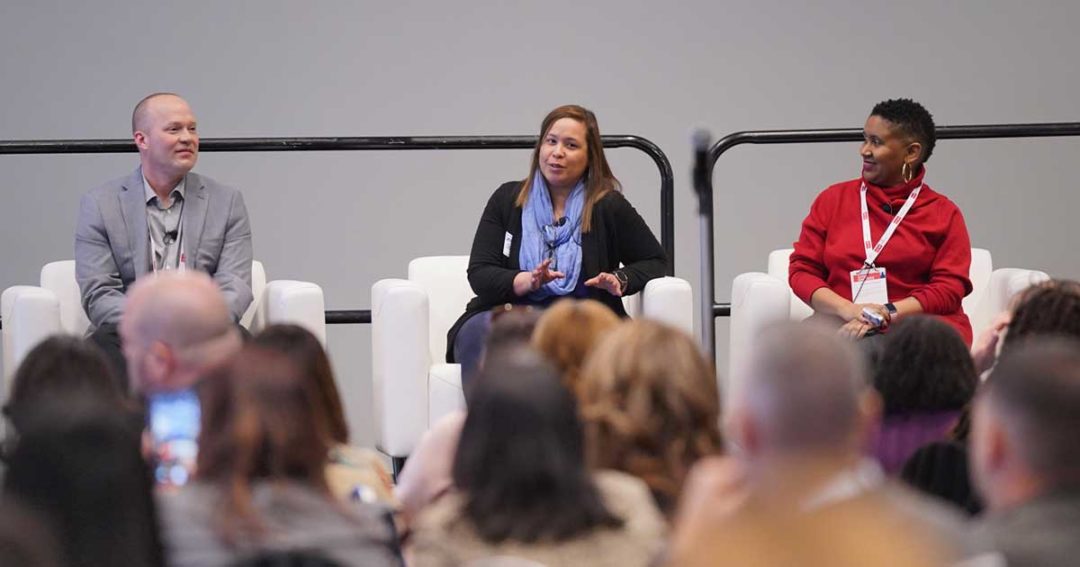
Taking DEI to the next level
Roundtable panel offers key takeaways for development.
To be successful, a diversity, equity, and inclusion (DEI) journey requires consistent care, feedback, and benchmarking. The DEI Roundtable preceding the CUNA GAC Sunday offered participants insight on how to build and maintain the success of their DEI efforts.
“Our inaugural DEI roundtable offered an opportunity to network, share, learn, and be inspired by the thoughtful DEI leaders who are forging new paths,” says Samira Salem, CUNA’s vice president of diversity, equity, and inclusion.
Among the key insights offered by panelists:
Build a foundation. This includes developing internal leaders and team members, building a business case for DEI, benchmarking, and conducting external research. “You have to change your own mindset before you start changing the mindset of others,” says Sheila Milton, vice president of diversity, equity, and inclusion at $5 billion asset UW Credit Union, Madison, Wis.
Find your true north. “Many times, you might hear, ‘We’re not moving the needle,’” says Laura Sehres, vice president of diversity, equity, and inclusion at PSCU, St. Petersburg, Fla. “First, you have to find your needle. What is it you’re trying to do, and how you can measure that and move forward?”
Build capacity. “People need action behind the words, so they understand that this isn’t just a program, but a core value that you weave into everything you do,” says Emma Hayes, chief culture officer at $53 billion asset SECU, Raleigh, N.C.
Define your commitments. Every organization has a different vision of DEI, according to Jackie Martinez-Vaszquez, vice president of diversity, equity, and inclusion at $30 billion asset BECU, Tukwila, Wash. Some desire to be leaders within their communities, others are content as fast-followers or role models. Regardless of the approach, it must be intentional, defined at an organizational level, and understood within the community.
Create employee resource groups (ERGs). ERGs are voluntary, employee-led groups that foster inclusive workplaces. These groups are invaluable for creating healthy conversations and understanding within organizations, according to Lindsay Taplin, assistant vice president of diversity, equity, and inclusion at $1.1 billion Seattle FCU. An overarching goal isn’t essential to these groups, but it is critical that each group understands the common reason behind its formation, according to Taplin.
Involve the community. “Members can go anywhere, but they might choose your institution because of its commitment to DEI,” says Cynthia Colon, assistant vice president of multicultural strategy at $2.9 billion GTE Financial Credit Union, Tampa, Fla. “But first you have to know your ‘why’ and tell them that ‘why.’”
Develop inclusive lending. Inclusive lending doesn’t always necessarily start with a lending product, according to Corey Rupp, chief retail officer at $3.9 billion asset Affinity Plus Federal Credit Union, St. Paul, Minn. Rupp suggests taking the time to understand the communities the credit union is trying to serve before developing lending products.
Appreciate the diversity of the team. It’s important to understand that even those working within the DEI initiative will have differing mindsets and approaches to cultural change and inclusion, notes Angela Russell, vice president of diversity, equity, and inclusion at CUNA Mutual Group. “All of the parts of the team matter,” Russell says. “You have to intentionally foster a sense of appreciation of the differences across the team.”
►Visit CUNA News for more conference coverage. Get live updates on Twitter via @CUNA_News, @cumagazine, @cuna, and #CUNAGAC. Follow the conference on Facebook and Instagram and visit cuna.org/gac for more information.